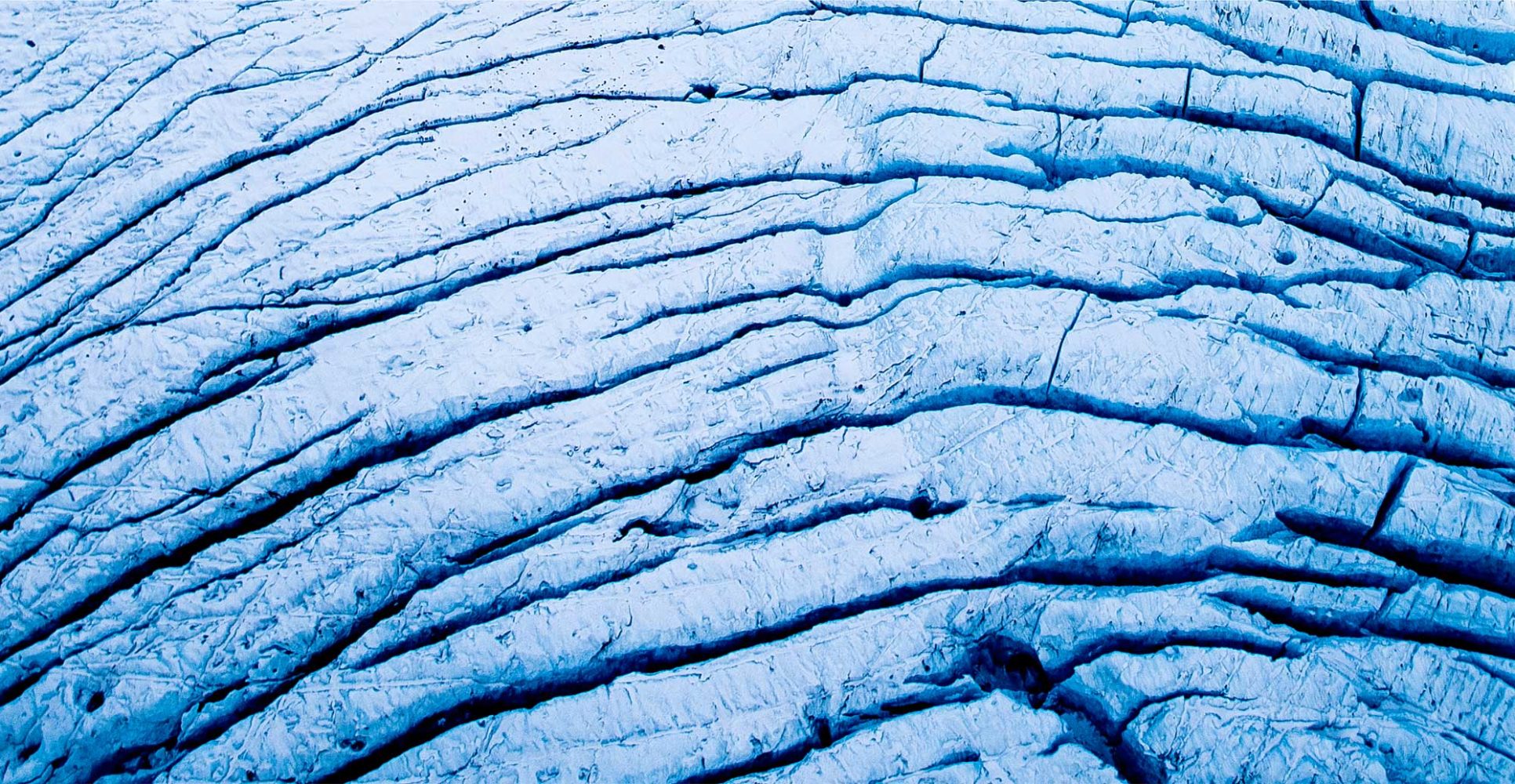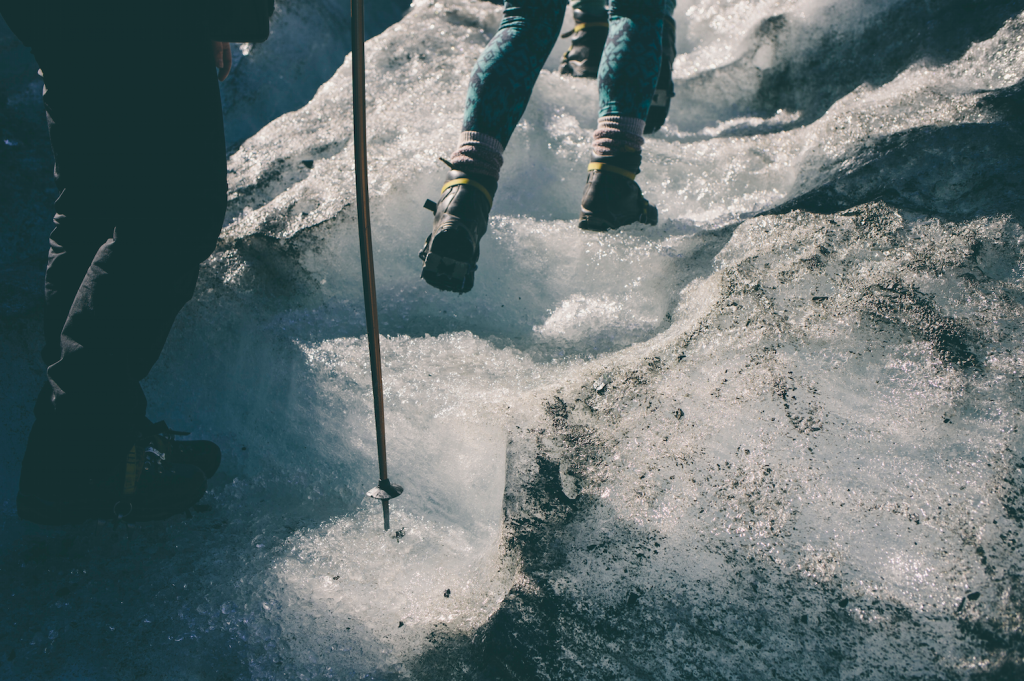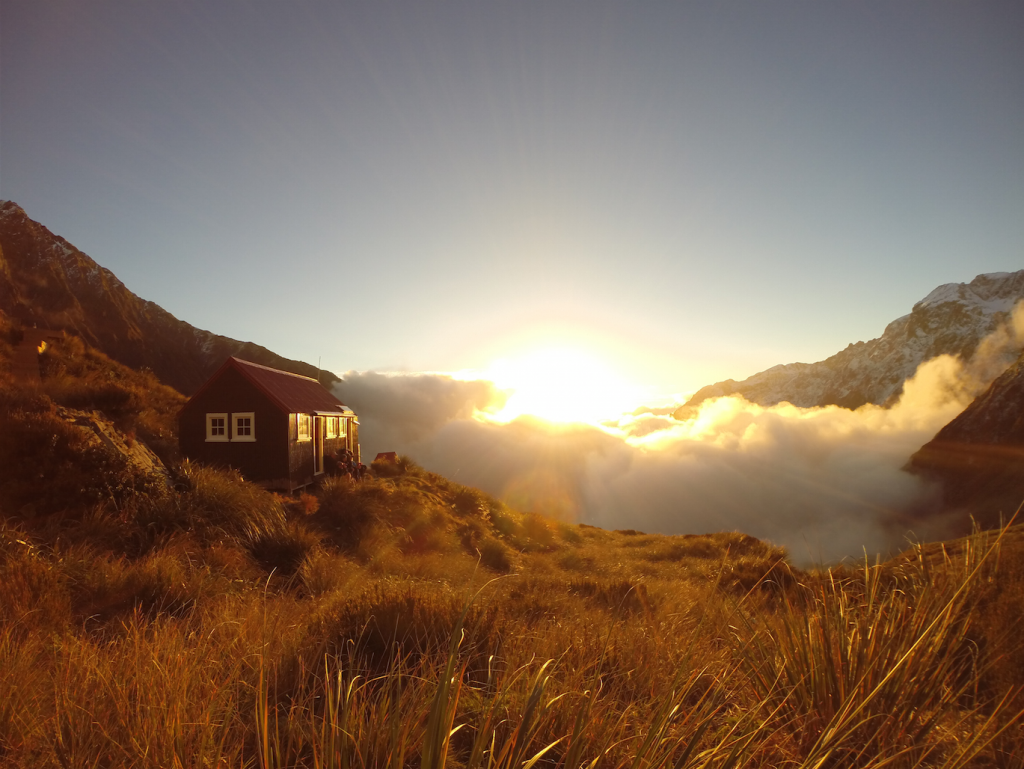Climbing Fox Glacier
Crampons? Check. Yes, crampons. I have never actually seen or held crampons before. Until now, they were just something that explorers and climbers on television wore: metal traction devices with spikes on the bottom that strap onto boots to make it possible to climb and cross ice. As a pair is handed to me at Fox Glacier Guiding headquarters, I feel like a budding mountaineer. After a safety briefing, we are ready to take on our ice challenge.

The helicopter ride to Chancellor Dome Hut — the starting point for the climb — is magnificent, and as we fly further up the Fox River valley I am filled with excitement, knowing that we will be climbing this very glacier the next day. Stepping out of the helicopter, a gust of crisp mountain air slices through me. The ‘clean’ feeling that it carries with it is absolutely sensational. We drop our overnight gear into the hut and assemble our day packs for the first part of our tour to Alf Glacier. We take a route that ascends through snowgrass basins, with views to the upper ice fields and falls. The walk is gentle at first and I wonder if this is as challenging as it will get. I want more: I was expecting a real ‘alpine’ experience and won’t settle for less.

I consider myself to be young at heart and hope to remain so for the rest of my life. Admittedly, during my teenage years there was the usual juvenile desire to be ‘grown up’, but that was a short-lived phase. Upon hitting my mid-20s, I began to appreciate and value my child-like tendencies, slowly embracing them and realising that they are a key part of who I am. However, one significant difference between my younger self and the person that I am today is my relationship with fear. It has slowly insinuated its way into my life, and awareness of this has triggered a mission to cure myself of this affliction.
Consequently, the last year has seen my life erupt into a period of enjoying new experiences and saying ‘yes’ at every opportunity — regardless of whether I actually want to try something or not. Although I have been trying to practice this new mentality for some time, I consider myself far from ‘cured’. I do, however, feel closer than ever to the young girl who ran wild without looking over her shoulder.
We stop to prepare safety ropes for an ascent of a steep rock gully. Perhaps I spoke too soon. One look up and I realise the gully’s faces are close to vertical. Could we not just walk a little longer? One step at a time: without looking down, I begin my ascent, though not so like Sir Edmund after all. In fact, I’m starting to feel a little frightened, but Marius and Richard, our expert guides, are reassuring. They continually encourage me to keep climbing inexorably upwards, and my focus narrows to each following step.
I begin to enjoy the feeling that comes from this total concentration and sense of connection with the rock face in front of me. It reveals layers of antediluvian sediment, some of which is frittered and loose. Eons of heating and freezing continually loosen the outer layers of rock and perpetuate the battle between the forces of mountain building and erosion — processes still clearly at play on the margins of the Southern Alps. We have to be extremely careful that we don’t kick loose rocks onto the person below us. After what seems like an eternity, we finally make it to the top. Raw relief washes over me.

The gully gives us access to a broad ridge and a snow shelf, 1800 metres below the summit of Chancellor Dome. Here, we put on our crampons and start walking on ice for the first time. We are told to give our steps ‘height’ in order to avoid tripping and falling on our faces. I perhaps take this advice too far, stomping as high and hard as I can. The rest of the team laughs at me but I do not mind — better to be safe than sorry. I stomp all the way to our lunch spot, thoroughly enjoying my newfound hobby. Waves of hard crusted white and pale blue ice flank our path and narrow fissures provide a constant reminder of the dangers posed by the glacier’s grinding passage down the mountain side surrounding us.
As we sit for lunch, the clouds clear, allowing us unobstructed views of the Southern Alps’ highest peaks and the broad spread of snowfields that feed Fox Glacier. We can see the mountains of Cook, Tasman, Lendenfeld and Haast — even the surf of the Tasman Sea breaking on Gillespies Beach. We feel omniscient, a well-deserved reward after such a climb.
Hard work should always be followed by some playtime, so we decide to climb a steep ice slope and practice self-arresting. The men find it easy to take on this challenge; it’s not so easy for me. They slide down the slope on their backs and then turn over, hacking into the ice with their axes to stop a fall or slide. I am almost ready to give up on this task but a few of the men keep goading me on, and my feminist desire to be treated as a true equal overrides my fear. I must prove I can do this as well as any of them — if not better. I slide down the slope, picking up speed. Oh dear. I really want to stop now. I quickly turn to my left, and slam my axe down into the ice. I pull up almost immediately and suddenly realise that I have full control of the situation. Riding a wave of relief and a newly realised sense of freedom, I slide and stop, slide and stop, all the way down the slope.

As we make our way back towards Chancellor Hut, I reflect on the gully we came up earlier that day. What goes up, must come down. However, upon arrival at the gully, I am not sure if I have enough in me to complete the return journey. I am tired, my legs and shoulders hurt, and it is a long way down. It is also raining; the rocks are slippery and the entire proposition seems much more dangerous. I am losing confidence quickly and have real doubts about my ability to complete the descent. I become aware that I have used the words ‘I can’t’ far too many times during this hike – thinking if not speaking them — and realise that old habits are hard to cure. Fear is still my bedfellow. However, Richard chimes in and says, “You can.” Somehow, my body listens and does as it’s told.
Marius and Richard get the ropes ready for our abseil down. Jin, another member of our team, and I are attached to the same rope, and Richard lowers us down slowly. He tells us to talk to each other, while his experienced hands navigate our descent. I realise very soon why constant communication between ourselves, as well as with Richard, is so important: when Jin moves to the left, I am swung to the left; when he moves to the right, I am swung to the right. We do not communicate effectively at first and as this creates a pendulum which results in me being repeatedly bashed into the rock wall. I decide to get a lot more vocal. I ask Jin to let me know where he is going next. He tries to tell me, but our movements are still out of sync.
In the meantime, Richard eases up on the rope’s slack: we’re not going anywhere in a hurry. Jin gently informs me that he will move to our right — just a little — in order to work around a large gap in the rock. Am I ready? Of course not. Still, Jin eases me through the transition: “Just breathe.” In this way, we make our way — ever so slowly, but more in control — down the rock gut. Looking down, I am unable to judge how much longer our ordeal has to run, as thick fog surrounds us. However, we do eventually reach stable ground in one piece.
We arrive back at Chancellor Hut, a pack of drenched and hungry rats. It’s a wonderful feeling to get changed into warm, dry clothes and then be handed a cup of delicious miso soup, to be enjoyed with an assortment of cheese and crackers, ready and waiting on the table. I reminisce about high school days completing the Duke of Edinburgh Award, tramping for a full day and then retreating to a hut in Auckland’s Waitakere Ranges. Those are some of my fondest memories, and I feel like I have just replayed my teen years in a setting far more challenging. After some meaningful banter over a Thai stir-fry prepared by Marius and Richard, my body is limp and exhausted. Delightfully content, I climb into my bunk bed and burrow into my sleeping bag, ready for Fox Glacier the following day.

With the morning sun a downhill battle looms, through an entirely different type of ecosystem. Hugging the margins of the glacial valley, today’s alpine vegetation zone comprises thick brush, mud, ditches, streams and waterfalls. It certainly provides contrast to the previous day’s rock and ice. I find that I prefer this type of hike, feeling more ‘at home’ in this setting. I enjoy being more cossetted by nature and its various elements: we do not even know where the path is, instead working our way through the dense green vegetation. It’s also wet and immensely muddy, but I do not mind at all. I feel rejuvenated and am again ready to take on the challenges that nature has in store for us.
Thanks to the help and reassurance of Richard and Marius, my confidence has been enhanced immeasurably over the course of this trip. Richard notices this as well, and we put it down to the fact that deep down I am still ‘Mowgli’: a wild Indian jungle child — I am just not quite at home yet on a bare mountain side. I have also learnt a little trick along the way, one that I use throughout my descent. When in doubt, I sit on my bottom and slide, slide, slide. I slide over slippery rocks, foliage and mud. Anyone searching for me knows where to look: down, because 80 per cent of the time I am trekking on my rear.
I slide my way, all the way down to the face of Fox Glacier. It stands majestically in front of us. We pop our crampons back on, pull out our ice axes, and clamber over the side of the glacier’s fissured terminus. Its striations and crevices — cast in whites, blacks, blues and greys – make the glacier look like an uncut, rough diamond. Sadly, it has retreated more than 300 metres over the last year due to its sensitivity to precipitation and human-induced temperature rises. Suddenly, I realise that my fears have shifted outwards, from those related to self-belief and personal harm to concerns about the environment on which I tread. While the world of our inner selves is opening up before us, the very landscapes that afford so much of our inspiration and a sanctuary from the pressures of everyday life are retreating and rapidly eroding. The circle of life is a balancing act.
